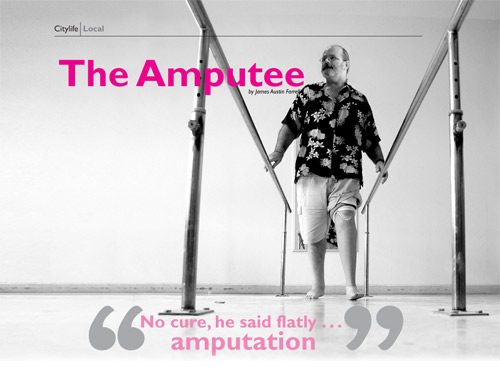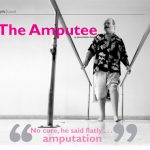
“I was in Laos getting a new visa and suddenly my foot turned blue, it was cold, there was no blood getting to it. I tried to lie down but couldn’t, it was excruciatingly painful.”
Greg Wallis, a 57-year-old American who’s lived in Chiang Mai for almost a decade, tells me this while fitting for a new leg, a prosthesis he hopes will be the last one he has to try on. I’ve known Greg about eight years, back when he had two feet, and was only slightly faster on them than he is on one.
He walks through the parallel bars on his new (the fourteenth so far) prosthetic limb, with a look of concentration on his face. “This one’s a good fit,” he says, looking up, just as an old woman is wheeled into the room, followed by her family who are carrying her full (from the hip) prosthetic limb behind her. “The stump evolves,” he explains, wiggling it around while showing me the scar’s journey around its periphery, “it’s totally changed since the amputation, so I have to keep coming back for replacements. Fingers crossed, this is the one.” He looks over to a man striding out of the building, “at some point, I wanna walk like him.”
Greg wouldn’t deny that back in the day he was a pretty committed smoker, and not such a bad drinker either. It was smoking, the doctors told him, that was the main reason for his condition, while the secondary cause was high cholesterol. The condition was a hardening of the arteries – ‘arteriolosclerosis’ in medical terms – where there is a build up of plaque in the veins which eventually cuts off the blood supply. “I’d had symptoms,” says Greg, “but I didn’t really know the signs, some of which were consistent cramps in the calf, and in the arch of the foot.” In Laos the blood supply to his foot had reached minimal velocity, hence the de-colouration and pain he felt. After a hellish odyssey getting back to Chiang Mai, Greg was given the prognosis. He needed a double bypass to get the blood flowing again, but after harvesting veins from one leg to the other and reviving some blood flow the foot still wasn’t receiving enough blood. He consequently developed gangrene. “No cure,” he explained flatly . . . “amputation . . . but I was ready for it.”
[right]The Parrot Sketch
[/right]
Greg was given what most might think a frightening, and somewhat starkly limited list of options. Don’t amputate: die. Decide to amputate, above the knee, and there is a 20 percent chance of gangrene reoccurrence, below the knee, a fifty percent chance, and below the ankle, an eighty percent chance. A reoccurrence of the gangrene would more than likely be the end of days for Greg. “I elected for below the knee . . . I was confident as the previous harvested veins had taken well.” So far so good, he says about his decision.
“I had to get rid of the pain,” he replies when asked about the fear of losing his leg, “I had to move on. After the double bypass I received a double lumbar puncture to dull nerves in my foot, and it worked except for the big toe, which I could still feel, so all the pain was concentrated there. It felt like a nuclear explosion in my toe.” He said after the amputation _ that was in April 2009 – he was relieved to not have the pain anymore, though quite naively thought that, “after a few days in the hospital they’d give me a phony leg and I’d walk away!” He was very wrong. Greg would have umpteen ‘phony’ legs and have to endure abrasions and pains and swelling of his stump for many months. His family – of which there was a new member, Greg’s baby daughter, born shortly before the amputation – was “heroic” in taking care of him. “It was like they were looking after two babies,” he says, adding “imagine trying to get off the toilet with one leg.” His friends too were all very supportive, one of which – a UN Irish Pub stalwart where Greg is quizmaster – gave him a parrot as a post-op gift (that was eventually stolen). Greg has great admiration for his family and friends who’ve helped him, but also for the Prostheses Foundation in Chiang Mai who, he says, “made it actually pleasurable attending appointments over the year I’ve been getting replacements.”
[right]The Prostheses Foundation
[/right]
The foundation, which was started by the Princess Mother, is located on the left side of the Irrigation Canal Road not far from the turning into Huay Tung Tao Lake. Inside the main entrance is a vast open space with paintings of the royal family. Through the hall is the workshop where technicians are busy drilling, sanding, sawing, sticking, combining the processes of making the prosthetic limbs. Not only has the foundation made limbs for over 17,000 people (at no charge) but it has made limbs for elephants, dogs, horses and birds. This is a remarkable achievement that has gained interest from many other countries that send medical professionals and technicians over to Chiang Mai so they may emulate the organisation’s work in their respective countries.
Ass. Prof. Therdchai Jivacate, MD, is the secretary general of the foundation and has been since its inception in 1992. Before that, he worked at the prosthetic unit of Suan Dok hospital’s physical rehabilitation department. “We had to import the parts, and for a below-the-knee leg it would cost 7,000 baht,” the doctor tells us, “but by using substitute parts locally made I could cut the costs by about half.” This was still too expensive so he came up with an idea to make the parts from waste plastic products, mainly from Yakult yoghurt milk bottles. He could now produce a leg – below-the-knee – for about 700 baht. “I would pay with my own money if the amputee was poor,” he says, and this, along with the doctor’s innovations, got the attention of the Princess Mother, who decided to set up the foundation in Chiang Mai with Dr. Therdchai as secretary general. “Our main objective is to provide amputees with artificial legs regardless of religion or nationality, to use locally made materials, and to train prosthetic technicians.” (Many of the employees at the foundation are amputees.)
“I noticed that people in rural areas could not make it to the foundation so I set up a mobile unit,” he explains. The mobile unit travels all over Thailand and there are also ‘community prosthetic workshops’ throughout the country, so now the foundation can reach just about everyone.
The technique they use – called sand-casting – is so efficient and quick, a person can hop into the foundation in the morning and walk out in the afternoon. They’ve become so well known for their progress and dedication that countries which have high rates of amputees have visited Chiang Mai to learn from the foundation. In May the foundation held a workshop in Penang; and in July there will be one in Kuala Lumpur, and in September, Borneo. These ‘satellite workshops’ train staff so they too might learn how to make durable, functioning, artificial legs, at no cost to the amputee, without having to import expensive parts from the west. The amount of amputees in a country such as Thailand is higher than countries in the west due to landmines along the border regions – landmines are responsible for most of the amputees in the country’s rural areas.

In city areas the highest amount of prosthesis recipients are casualties of motor accidents. In the west the most common cause of amputation is arterial disease, the main problem being high cholesterol. Talking about the foundation Greg said emphatically, “They take care of you and ask for nothing at all in return, such a rare thing in life.”
[right]Life on One Leg
[/right]
Greg’s 14th artificial leg was in the workshop being made into something that would look like a real leg. The trial prosthetics are for practical purposes only, not aesthetic, and so reveal the ‘bone’ (metal rod) which inspired the purchase of the now-lost parrot. While the technicians work on the finishing touches – the amputees have options, one being a tattooed shin – we talk about his new life on one leg.
“I’ve five less nails to cut and I definitely don’t miss that in-growing toe nail . . . I also get a good seat when I go to immigration,” says Greg laughing, then becomes more serious and explains, “I had to make a decision, it wasn’t taken from me. I had a choice.” He tells me that it wasn’t as if he was given a death sentence and doesn’t feel bad about what happened. He does, however, regret that he ever smoked, though adds that he could never feel sorry for himself. He also explains that in one way the disease he contracted was felicitous and ended up making him the poster boy for the UN Irish Pub’s cricket team which for many years had already been named the UN Irish Pub Gang Green. Greg, and no doubt many more of his friends, might have discovered a levity that has given them a few laughs, though he does add that there are still some awkward moments resulting from being ‘legless’. “People say sorry to me and I think, why, it’s not your fault. Others have told me they’d pray for me . . . absurd. Pray for peace, not my missing leg.”
 Even though Greg does still get some gip from his phantom foot he seems in very good spirits and looks a lot healthier than he did prior to all that has happened. “Things that seem insurmountable in the beginning are thrown by the wayside in the future,” he says philosophically. “I’m never gonna dance the lead in Riverdance, but that’s probably better for everybody . . . It’s only a tragedy when you think it’s a tragedy.”
Even though Greg does still get some gip from his phantom foot he seems in very good spirits and looks a lot healthier than he did prior to all that has happened. “Things that seem insurmountable in the beginning are thrown by the wayside in the future,” he says philosophically. “I’m never gonna dance the lead in Riverdance, but that’s probably better for everybody . . . It’s only a tragedy when you think it’s a tragedy.”
The Prostheses Foundation is always in need of donations.
www.prosthesesfoundation.or.th
prosthesesfoundation@hotmail.com
